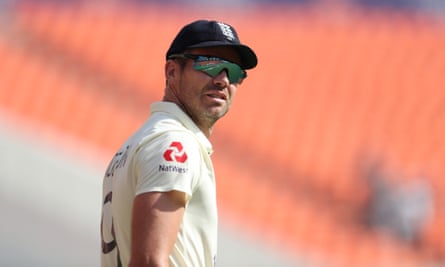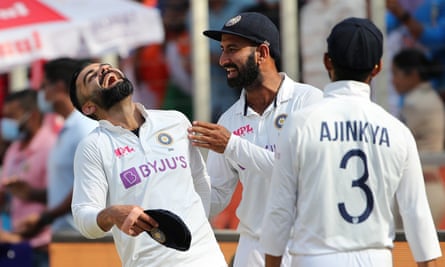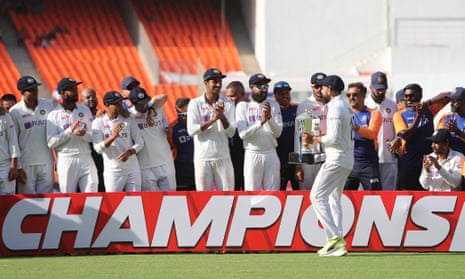England
Joe Root: 368 runs at an average of 46; six wickets at 24; three catches
Root carried his sensational form from Sri Lanka to Chennai to deliver a win for the ages, sweeping a double century to set up the series. Subsequently, he failed to make more than 33, as India’s spinners’ patience preyed on his fatigue. Despite having much more than a popgun attack, he couldn’t stop Rohit Sharma’s series-changing boundary barrage in the second Test, nor Ravichandran Ashwin’s nails-into-coffin century in the second dig. Even though hge picked the wrong team for both of the matches he needed to win, he remains a personable character who was as amazed as anyone with his five-fer. Maybe that charisma, his record of victories and his status as an all-time great batsman protects him from more forthright criticism after defeats in which England were ultimately barely competitive despite gaining footholds in all three Tests. Grade B-
Dom Sibley: 134 runs at 17; one catch
This resourceful cricketer appeared to have done his thing with 103 runs chiselled out of the first Test’s red earth. Only 31 more were added to the ledger as technical deficiencies, crumbling confidence and bad luck did for him. Grade C
Rory Burns: 58 runs at 15; three catches
The two ducks are an occupational hazard for an opening bat, but to have twice batted for an hour and got out must have infuriated him and, ultimately, cost him his place. He still has plenty of heart but, with so few straight lines in his set-up and defensive play, he looks vulnerable to lateral movement, spin, seam or swing. Grade C-
Zak Crawley: 67 runs at 17; two catches
In a magnificent half century, he looked like the new Barry Richards: fluent drives, fierce pulls and cuts, the bowler given no margin for error by his height and decisive footwork. But once Axar Patel and Ashwin skidded the ball on to him, an almost imperceptible but fatal hesitation undid him. Grade B-
Dan Lawrence: 149 runs at 25; no wicket for seven runs
Like the new kid in a Sunday XI, he batted wherever he could get a game and (backhanded compliment klaxon) fitted into this England team well. He improved as the challenge became tougher by sticking to a well conceived plan to play the turning ball – the old-fashioned one of going fully forward or fully back. Grade B-
Jonny Bairstow: 28 runs at seven
It took a lot more time to get home and back after the Sri Lankan leg of the winter than it took to get to the crease and back in India, the last of an horrendous portfolio of dismissals a first baller glanced straight into the hands of leg slip. There were mitigating factors, of course, but one wonders what the phalanx of coaches and support staff were doing with him that led to such a calamitous collapse in the basics of batsmanship. Grade D-
Ben Stokes: 203 runs at 25; five wickets at 31; five catches
After an unexpected day off to start the series, he came in and biffed a good position into a very good position with all the bristling aggression with which we have become familiar. He finished the series with a mind-over-matter gig as an opening bowler, in which all his skills and hostility with the ball were showcased. But he couldn’t find that game-changing spell or that signature innings, too often beaten by relatively innocuous deliveries when looking as good as any Englishman at the crease. Grade B-
Ollie Pope: 153 runs at 19; five catches
He will be a better batsman for a chastening experience in which he was made to look like a rabbit in the headlights or a cat on a hot tin roof, stuck mesmerised as the delivery dipped in flight or running at the ball in hope as much as expectation of a clean connection. Grade C-
Jos Buttler: 54 runs at 27; five catches
Twice he arrived at the crease with England very comfortable, nevertheless he batted solidly rather than spectacularly. He was tidy behind the stumps but, like his Indian counterpart, was shown to be a batsman first, wicketkeeper second, by Ben Foakes’ next-level glovework. Grade B-
Ben Foakes: 78 runs at 16; four catches and three stumping
On either side of the popping crease, he watched the ball all the way and used a firm base and still head to make good on the descriptor “wicketkeeper-batsman”. But his scoring options were limited, which is not what you want batting with a weak tail, and mistakes crept into his keeping too as India crushed England’s spirit. Grade B-
Moeen Ali: 49 runs at 25; eight wickets at 28; one catch
A late start and early finish for Moeen’s winter but he burned brightly when given his chance, especially with a blaze of (alas inconsequential) sixes as England slumped to defeat in Chennai. He dismissed India’s captain and vice-captain twice in his one Test and bowled his by now familiar mix of four balls and wicket-taking deliveries with too few stock balls in-between. For all his watchability, the question remains: are you going to win many matches on spin-friendly pitches with a frontliner conceding 226 runs at close to four an over? Grade C
Dom Bess: 64 runs at 16; five wickets at 39
He was treated with little sympathy on and off the field when he appeared to be selected and then bowled reluctantly by a captain who clearly wanted to bolster his fragile confidence but just couldn’t in the cauldron of Test cricket. Spinners need to bounce back from adversity – his England and Somerset teammate can tell him that – but Bess has hard work to do at his new county, Yorkshire, where one hopes he will get enough cricket to groove an action and release that is too unreliable as things stand now. Grade D
Jofra Archer: 16 runs at 4; four wickets at 31
His speed through the air and ability to add 5mph to his stock delivery with no change in run up or action saw him knock over Shubman Gill twice and Rohit Sharma once in the three innings in which he bowled. His batting appears to have disintegrated. Grade B-
Jack Leach: 48 runs at 8; 18 wickets at 29; one catch
He delivered 95 more overs than any other England bowler and did not wilt in the heat nor under a premeditated assault from Rishabh Pant, who would have hit lesser men out of the attack. If he lacks a little mystery and skiddy pace off the surface, he makes up for it with consistency and spirit. If he had the luxury of bowling in tandem with a right-arm version of himself, his figures would have been more impressive. Grade A-
Stuart Broad: Nine runs at five; no wickets for 78 runs
He was shown the respect his status in the game demands by India’s batsmen but carried little threat on surfaces that lacked the seam movement and carry that his bowling needs. Grade C
Ollie Stone: one run at one; four wickets at 17; one catch
He hit the crease hard and bowled very fast to wring four wickets from a surface that gave him little support. Grade B
Jimmy Anderson: 12 runs at four; eight wickets at 16; one catch
A master bowler in all conditions, he gave little to hit and India’s batsmen were not inclined to force the issue. He swung the ball and worked over batsmen constructing overs and spells in the manner of a Warne or Ashwin. Almost half his overs were maidens – cricket from a bygone age. Grade A-

India
Rohit Sharma: 345 runs at 58; no wicket for seven runs; five catches
After the shock defeat in the first Test and losing his opening partner without a run on the board, he creamed the bowling to all parts of Chennai to take lunch on 80 not out, en route to a series-shifting knock of 161 that deserves to be considered one of the greatest this century. He also made contributions in the other two victories and, at times, looked like he was batting on a wholly different strip. Grade A
Shubman Gill: 119 runs at an average of 20; two catches
The talent is undeniable, but a technique that is more suited to freeing the arms and driving the ball on the up will be found out with Test lines and lengths supported by two slips and a gully. Grade C
Cheteshwar Pujara: 133 runs at an average of 22; three catches
Understandably a little jaded after his herculean efforts in Australia, his signature concentration was a little off and England had the tools to exploit it. Grade C-
Virat Kohli: 172 runs at 29; four catches
Rusty after paternity leave, the mojo was lacking in the first Test wake-up call. Thereafter, he had pitches more to his liking and Kohli-Cam was back to showing the familiar whoops of celebration, as events bent to his will with his bowlers (new man, Axar, handled particularly well) delivering just what he wanted. His batting never got going, but it wasn’t needed. Grade B
Ajinkya Rahane: 112 runs at 19; eight catches
His catching was more influential than his batting, but his one innings of substance ensured that Rohit’s masterpiece was not wasted. He probably has enough credit in the bank for continued selection, but will need runs soon if he is to push on to 100 caps. Grade C+

Rishabh Pant: 270 runs at 54; eight catches and five stumping
The new superstar of Indian cricket, he showed that his extraordinary batting in Australia was no flash in the pan, as he produced two innings of extraordinary confidence and invention. His strike rate of 84 was a full 30 runs ahead of Joe Root, who was no slouch, and his boundary count (32 fours and 10 sixes) was, like his balance of attack and defence, Gilchristian. His keeping improved in leaps and bounds for good measure. Grade A
Washington Sundar: 181 runs at 91; two wickets at 65
Plenty of Indian fans told us that, though he may have been selected as a back-up spinner down the order, he was a serious batsman. So it proved. He missed out on deserved centuries twice and he may find that a fit again Ravindra Jadeja and Axar – no mean batsman himself – are in competition with him for one place over the next couple of years, but talent has a way of breaking through. That said, don’t be too surprised to see him in Rahane’s slot at No 5 if his batting continues to develop. Grade B+
Ravichandran Ashwin: 189 runs at 32; 32 wickets at 15; two catches
He quickly worked out that he needed few of his tricks beyond the hard-spun drifter and turner and the hard-spun dipper and skidder to bewitch England’s batsmen into crease-bound impotence or crazy charges. Knowing he was unlikely to add to the tattoo of bruises left by Patrick Cummins and Josh Hazlewood on Chennai’s black soil pitch, he came in to play and few shots and kept going all the way to a century. Grade A+
Kuldeep Yadav: Three runs at two; two wickets at 21
He should have played in the first Test when a third spinner was needed, but played in the second, when he wasn’t. Grade C
Axar Patel: 55 runs at 14; 27 wickets at 11; one catch
His debut series – really? If India were allowed to create a cyborg bowler who was perfectly manufactured to exploit Indian conditions and English techniques, a robot Axar is what they would have come up with. His left-arm pacy deliveries that spun or hurried on from a high release point retained an immaculate line and length, proving much too much for batsmen who had seen little of its kind before – and didn’t hang around long enough to see much of it this time either. Four five-fers in three Tests did not flatter him, as it was only Ashwin’s excellence at the other end that prevented him bagging plenty more. Grade A+
Ishant Sharma: 26 runs at seven; six wickets at 27; one catch
He bowled with Andersonian skill to swing the ball, but was only ever going to be a warm-up act for the A-men at the top of the bill. Grade B
Mohammed Siraj: 20 runs at 10; three wickets at 23; one catch
The figures belie his hostile and street-smart pace bowling, which yielded few boundary balls and shook up batsmen looking for a bit of respite from trial by turn. It will be interesting to see him in England come August in conditions likely to favour his brand of all-action aggression. Grade B
Jasprit Bumrah: Five runs at two; four wickets at 32; one catch
After as disciplined and effective a display as one can expect in the series’ first innings with England, piling up 578, he came back after injury for the third Test in which he was surplus to requirements. Grade B-
Shahbaz Nadeem: No runs at 0; four wickets at 58
Recalled 16 months after his debut Test, he looked out of his depth and will be fortunate to be given another go in light of the progress of Axar and Washington. Grade C-

Comments (…)
Sign in or create your Guardian account to join the discussion